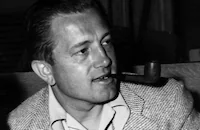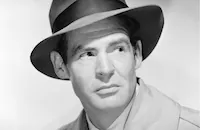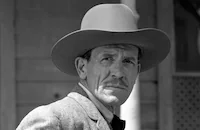Crossfire

Brief Synopsis
Cast & Crew
Edward Dmytryk
Robert Young
Robert Mitchum
Robert Ryan
Gloria Grahame
Paul Kelly
Film Details
Technical Specs

Synopsis
In a dark Washington, D.C. apartment, two men beat up another man and leave him for dead. A short time later, police captain Finlay, who has been called to the murder scene, questions Miss Lewis, the woman who discovered the body. Miss Lewis tells Finlay that, earlier in the evening, she and the victim, Joseph Samuels, were drinking in a bar with a trio of recently discharged soldiers, one of whom Samuels then invited to his apartment. After Miss Lewis states that she left Samuels alone with the soldier, returning only after Samuels failed to answer his phone, army sergeant Montgomery appears at the door, looking for Corp. Arthur "Mitch" Mitchell. Montgomery claims that he and another friend, Floyd Bowers, were with Mitch in Samuels' apartment, but that Mitch left abruptly, promising to return soon. As he has found the corporal's wallet in the apartment, Finlay determines to locate Mitch and brings his best friend, Sgt. Felix Keeley, in for questioning. While maintaining his friend's innocence, Keeley tells Finlay that Mitch, a painter, is suffering from post-war depression and is estranged from his wife Mary. Finlay then re-questions Montgomery, a former policeman, who describes Samuels as a draft-dodging "Jewboy." Montgomery repeats that, after following Mitch to Samuels' apartment, he and Bowers left shortly after Mitch. Concerned for Mitch, Keeley sends all of the servicemen in their hotel to search for him. With his friends's help, the corporal manages to elude some M.P's, and flees to a movie theater with Keeley. Mitch then tells Keeley his version of that night's events: After Samuels takes Mitch to his apartment, Montgomery bursts in with Floyd and picks a fight with Samuels. Suddenly ill, Mitch leaves Samuels' and meets a sympathetic taxi dancer named Ginny Tremaine, who invites him to wait for her at her place. There Mitch runs into an odd man, who claims at first to be Ginny's husband, then insists he is not. Unnerved by the man, Mitch leaves and staggers back to the hotel. Back in the theater, Keeley informs Mitch that Mary is in town, anxious to see him, then hears that Floyd has been found hiding out in Maryland. Before the police can question Floyd, Montgomery appears at his door, demanding that they "get their story straight." A nervous Floyd agrees to corroborate Montgomery's story to the police and promises not to speak to anyone about the incident. When Keeley and another soldier, Bill Williams, come knocking, Montgomery hides and eavesdrops as Floyd reveals that he called his friend Leroy, who was in the bar briefly with Mitch and Samuels. After Keeley and Bill leave, an enraged Montgomery beats and strangles Floyd, leaving him for dead. Later, Finlay questions Keeley about Floyd's murder and learns about Ginny. Keeley then meets with Mary and directs her to the movie theater where Mitch is still hiding. After reuniting with her confused husband, Mary offers to question the taxi dancer on his behalf and goes with Finlay to Ginny's apartment. Neither Ginny nor the strange man, however, can provide a convincing alibi for Mitch. Frustrated, Finlay re-interrogates Montgomery, who unwittingly exposes himself as the killer when he displays his hatred of Jews and thereby supplies a motive for the crime. Delivering a passionate speech on the evils of antisemitism, Finlay then convinces a frightened Leroy, who has been found by Keeley, to participate in a plot to trap Montgomery. In a men's room, Leroy tells Montgomery that he has just spoken with Floyd and that Floyd is demanding blackmail money from him. After Leroy gives him an address for Floyd, which lists the correct building but the wrong apartment number, Montgomery sneaks into Floyd's apartment. There he is startled to run into Finlay, who calmly points out that the only way that Montgomery could have known which apartment belonged to Floyd was if he had been there earlier. In a panic, Montgomery runs out of the building, but is shot dead in the street by Finlay.

Director

Edward Dmytryk
Cast

Robert Young

Robert Mitchum

Robert Ryan

Gloria Grahame

Paul Kelly

Sam Levene

Jacqueline White

Steve Brodie
George Cooper

Richard Benedict
Richard Powers
William Phipps

Lex Barker
Marlo Dwyer
Harry Harvey
Carl Faulkner
Jay Norris
Robert Bray
George Turner
Don Cadell
Philip Morris

Kenneth Mcdonald
Allen Ray
Bill Nind
George Meader
Crew
C. Bakaleinikoff
Gordon Bau
C. Bidwell
Charles Cirillo
Russell A. Cully
Albert S. D'agostino
Harry Gerstad
Alfred Herman
J. Roy Hunt
Nate Levinson
Sam Lufkin
Kid Ory's Creole Jazz Band
John Paxton
Clem Portman
Cliff Reid
Dore Schary
Adrian Scott
B. Scott
Darrell Silvera
John Sturtevant
John E. Tribby
William E. Watts
Roy Webb

Photo Collections
Videos
Movie Clip






Trailer
Hosted Intro


Promo
Film Details
Technical Specs

Award Nominations
Best Director
Best Picture
Best Supporting Actor
Best Supporting Actress
Best Writing, Screenplay
Articles
Crossfire (1947) - Crossfire
According to Dmytryk in his autobiography It's a Hell of a Life But Not a Bad Living, it was Adrian Scott who optioned the novel The Brick Foxhole for the screen: "It was a loose, rambling story of the frustrations of stateside soldiers at the end of the war. The book had a number of subplots, one of which concerned the murder of a homosexual by a sadistic bigot. Adrian had an inspiration: What if the murder and its aftermath were the whole spine of the story, and what if the victim was a heterosexual Jew? We could do at least a partial study of bigotry - particularly as it relates to anti-Semitism - and nothing like that had ever been done in Hollywood before."
At first Dore Schary was skeptical of the project. Despite his reputation for championing "message films," he felt that Crossfire would not appeal to the average moviegoer (this was based on a poll that showed only an eight percent interest by those polled). He also felt it would attract the unwanted attention of HUAC due to its controversial subject matter - anti-Semitism. Even with these qualms, however, the project was approved. In exchange for the relatively high cost of the name cast, which included Robert Young, Robert Mitchum and Robert Ryan, the shooting schedule was reduced to an economic timeline of twenty days. Yet, thanks to cinematographer J. Roy Hunt, the film's atmospheric low-key lighting was accomplished quickly and efficiently resulting in one of the most visually impressive film noirs ever. Regarding Hunt, Dmytryk said, "In 1947 he was almost seventy. He had gotten into pictures about Year One by building his own camera, and he had never stopped inventing. Half the improvements on RKO's special sound camera - the best in the business at that time - were of his design...Because of Roy's speed in lighting, we were also able to reverse the usual statistics on time of preparing versus time of shooting. On the average short-schedule film, setting up and lighting take five to ten times as long as the actual shooting. On Crossfire, my actors and I were in action at least twice as long as Hunt and his crew."
The dark, pessimistic look and tone of Crossfire was further enhanced by a career-making performance by Robert Ryan as Montgomery, a psychotic racist whose hatred of Jews was terrifying to behold. "Ryan's powerful performance resists the kind of neat, limiting social classification that the film wants to attach to his sickness," Foster Hirsch wrote in The Dark Side of the Screen: Film Noir. "He plays with an intensity that transcends the film's own boundaries as a liberal social document." Yet, despite the acclaim and an Oscar® nomination for Best Supporting Actor (he lost to Edmund Gwenn in Miracle on 34th Street), Ryan had mixed feelings about Crossfire. In some ways, he felt the movie contributed to his being typecast as a villain for most of his career and tried to distance himself from it in later interviews. Instead, he preferred to point to his performance as the washed-up boxer in the film noir drama, The Set-Up (1949), as his best work.
Equally impressive in Crossfire, though in smaller roles, are Sam Levene as the murder victim, Gloria Grahame as a pathetic barfly, and Paul Kelly as her bitter ex-husband, a dishonorably discharged soldier. Crossfire marked a real turning point in Grahame's career, one that earned her a Best Supporting Actress Oscar nomination. Grahame later said "Strangely, it was a dialogue director, Bill Watts on Crossfire, who first made me realize how to play movies. It's thinking. I was doing my hair for a scene and he said, forget the hair. And he started talking, and I forgot the hair, the makeup and everything. All he did was talk to me about who the character was, where she was, what she was until I was so immersed in what it was all about. After that, maybe I just did it for myself" (From Suicide Blonde by Vincent Curcio).
Robert Mitchum, who lends a quiet authority to Crossfire in his role as the cynical sergeant who helps with the murder investigation, was on his way to major stardom in 1947. He had recently been nominated for a Best Supporting Actor Oscar® in Story of G.I. Joe (1945) and would soon be reaping critical acclaim for his work in Out of the Past and Pursued, both released the same year as Crossfire. But during the filming of Crossfire, Mitchum pretended not to care too much about acting and was quite the prankster, tormenting cast and crew members with the new air-powered BB gun he just bought. "Steve Brodie, who played Floyd Flowers in the film, got shot in the leg. It gave him a huge bruise that he said lasted forever," according to Lee Server in Robert Mitchum: Baby I Don't Care. "Dmytryk's status didn't exempt him from becoming another target. "I was sitting on the set and it hit me right in the fanny. Shot by a BB gun. I looked around and caught Bob standing on the sidelines pretending not to be there."
Thanks to Dmytryk's tight shooting schedule Crossfire managed to beat a similar-themed film about anti-Semitism - Gentleman's Agreement - to the theatres and stole some of the latter film's thunder, but not in the Oscar® race. At the 1947 Academy Awards ceremony, Gentleman's Agreement won three of its seven nominations including Best Picture; Crossfire didn't win any awards despite five nominations. Still, the film was a critical success and a box office hit for RKO. And its theme is still relevant today. Regarding this, Dmytryk wrote in his autobiography, that "After our rough-cut showing to the sound and music department, one of the young assistant sound cutters, an Argentine, complimented me on the picture.
"It's such a fine suspense story," he said. "Why did you have to bring in that stuff about anti-Semitism?"
"That was our chief reason for making the film," I answered.
"But there is no anti-Semitism in the United States," he protested. "If there were, why is all the money in America controlled by Jewish bankers?" I stared at him in astonishment. "That's why we made the film" was all I could think of to say."
Producer: Dore Schary, Adrian Scott
Director: Edward Dmytryk
Screenplay: Richard Brooks (novel), John Paxton
Cinematography: J. Roy Hunt
Film Editing: Harry Gerstad
Art Direction: Albert S. D'Agostino, Alfred Herman
Music: Roy Webb
Cast: Robert Young (Capt. Finlay), Robert Mitchum (Sgt. Peter Keeley), Robert Ryan (Montgomery), Gloria Grahame (Ginny Tremaine), Paul Kelly (Mr. Tremaine), Sam Levene (Joseph Samuels).
BW-86m. Closed captioning.
by Jeff Stafford

Crossfire (1947) - Crossfire
Quotes
Okay, where were you when he needed you? Maybe you were someplace having beautiful thoughts. Well, I wasn't. I was in a stinkin' gin mill, where all he had to do to see me was walk in, sit down at the table and buy me a drink.- Ginny
You still don't know where he is?- Police Captain Finlay
No. I didn't know when I came in here, and I haven't suddenly gotten any brighter.- Keeley
What kind of guys?- Police Captain Finlay
You know the kind. Played it safe during the war, keepin' themselves in civvies, nice apartments, swell dames... you know the kind.- Montgomery
I'm not sure that I do.- Police Captain Finlay
Some of 'em are named Samuels, some of 'em have funnier names.- Montgomery
He oughta look at a casualty list sometime. There's a lot of funny names there, too.- Keeley
Trivia
Notes
The working titles of this film were The Brick Foxhole and Cradle of Fear. In Richard Brooks's novel, the character "Montgomery" kills "Samuels" not because he is a Jew, but because he is a homosexual. PCA director Joseph I. Breen described the novel in a July 17, 1945 letter to RKO executive William Gordon, contained in the MPAA/PCA files at the AMPAS Library, as "thoroughly and completely unacceptable, on a dozen or more counts." In February 1947, however, after screenwriter John Paxton had completely eliminated the homosexual plot line from the story, Breen endorsed the project, but cautioned that the final film should contain "no suggestion of a 'pansy' characterization about Samuels or his relationship with the soldiers."
Contemporary news items add the following information about the production: In March 1946, Dick Powell, who had previously starred in two successful Edward Dmytryk/Adrian Scott/John Paxton pictures, Murder My Sweet and Cornered (see entry above), was announced as the film's probable star. Robert Young eventually agreed to do the picture on condition that it be shot on a twenty-four day schedule, which it eventually was. RKO borrowed Gloria Grahame from M-G-M for the production.
A March 1947 New York Times article described Crossfire as one of the first Hollywood films of the 1940s to "face questions of racial and religious prejudice with more forthright courage than audiences have been accustomed to expect." While RKO was producing Crossfire, Twentieth Century-Fox was making Gentleman's Agreement (see below), another story about antisemitism. RKO raced to beat the much "ballyhooed" Fox picture to the theaters, releasing Crossfire several months before Gentleman's Agreement. In July 1947, RKO screened Crossfire for representatives of various Los Angeles religious groups. In addition, several surveys, which were designed to gauge the audience's prejudices, were conducted before and after screenings of the film. Crossfire received both praise and criticism for its depiction of antisemitism in America and was the subject of many editorials. Some Jewish leaders protested Montgomery's extreme brand of antisemitism, which they felt could be too easily dismissed by the audience.
Crossfire was Dmytryk's and Scott's last film for RKO. In October 1947, the House Committee on Un-American Activities (HUAC) called the filmmakers as "unfriendly" witnesses before their Congressional hearings. HUAC, which was formed by Congress in 1938 to investigate a variety of political extremists, had dedicated itself solely to exposing Communist and left-wing activities after World War II, and, in late 1947, turned its attention specifically to the film industry. Scott and Dmytryk became the first two members of the infamous "Hollywood Ten," a group of producers, writers and directors who were indicted for contempt of Congress when they refused to state whether they were or had been Communists. Other members of the Hollywood Ten included screenwriters Alvah Bessie, Lester Cole, John Howard Lawson, Dalton Trumbo, Ring Lardner, Jr., Samuel Ornitz and Albert Maltz and producer-director Herbert Biberman. In April 1948, the Hollywood Ten were tried at the Federal Court in Washington, D.C. and were convicted of contempt of Congress. All ten served prison terms and, for many years, were blacklisted from the film industry. Some, including others who were implicated in later years, continued to write using pseudonyms.
In January 1948, Dmytryk, whose contract at RKO was dropped after the indictment, sued the studio for $1,783,425, claiming anguish, loss of salary, screen fame and artistic reputation as well as personal humiliation due to his firing. The disposition of that lawsuit has not been discovered. In September 1950, however, the imprisoned Dmytryk broke his silence, stating that he was once a member of the Communist Party, and was released early from jail. When Dmytryk testified a second time for HUAC in 1951, he implicated others, including Scott, as Communists, and thereby removed himself from Hollywood's blacklist. His next American-made film was the 1952 picture Mutiny. Scott, however, continued to be blacklisted and never produced another picture.
Because of its modest $589,000 budget, Crossfire was touted as a model "sleeper" hit. According to modern sources, it grossed $1,270,000 and was RKO's biggest hit of 1947. Crossfire received an Academy Award nomination for Best Picture, but lost to Gentleman's Agreement. It was also nominated for Best Supporting Actor (Ryan), Best Supporting Actress (Grahame), Best Director and Best Screenplay (Adaptation). In September 1947, Crossfire was named Best Social Film at Cannes. In December 1947, Ebony magazine, an African-American publication, gave the film its annual award for "improving interracial understanding."
















